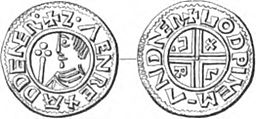Viking coinage
[3] Within Scandinavia itself, Vikings were aware of coins from various regions including the Arab areas of the day, bringing further influence.
[3] Danish ruled kingdoms in the British Isles, known as the Danelaw, began to model their own coins on rulers in addition to various Christian imagery.
[3] The finds of multiple silver hoards within the United Kingdom and Scandinavia, provide evidence of the types and design of coins of the various Viking rulers and kings and the influence of outside cultures.
[5] In addition, hoards found in Denmark and Sweden show a large proportion of Arabic coins, as well as other forms of bullion such as bracelets and jewellery.
[3] Some suggest Scandinavian coins developed in the town of Ribe towards the early eighth century with evidence of Danish sceattas, however no archaeological remains of a particular mint have been found.
[4] The development of a bullion economy within the Viking Age saw goods exchanged for precious metals based on their weight and size as opposed to use of a particular type of coin.
The silver was often weighed using lead weights and in order to safeguard people's wealth, melted down to be shaped into various other forms (such as bracelets and other jewellery).
[9] Towards the ninth century, raids took Vikings into contact with various towns and villages around the North and Irish Sea.
Naturally, following raids of foreign nations, the Vikings became more accustomed to and more involved in local politics and economics.
[10] The various Anglo-Saxon kingdoms already had their own coinage in use, which was often used to pay Vikings off in attempts to avoid raids, not necessarily always being successful.
[15] The initial implementation of the Danish coinage began well, becoming further consolidated and established under the rule of Cnut, whereby the kingdoms of both Denmark and England were more united.
[13] As in other parts of Viking Scandinavia, imports of coinages and coins from various regions of the world, entered their way into present day Norway as a result of increased trade.
Locally issued coinage is likely to have continued within Norway, evidenced from the composition of multiple found coin hoards.
[15] Initially, the distributed coinage within Norway, had a delicate start, but under the rule of Harald Hardrada, became much more influential.
Predominantly, dirhams were imported into Sweden via Russia, with additional circulation coming from Germany, England and elsewhere.
[18] Sweden’s native coinage began towards the 990s with the king Olof Skötkonung, issuing coins with his own image and title.
[16] King Anund Jacob continued the minting of coins in Sigtuna but was discontinued towards the end of his reign.
These coins could have been used as a means of payment for soldiers as opposed to having a sole use in trading, resulting in this primitive type of coinage.
Scandinavian influences on the coinages are also evident in addition to the Christian imagery, such as the hammer of the Norse god Thor and other references.
As well as the coins found in the hoard, over 36 kg was bullion, mainly consisting of silver jewellery and other smaller metals.




